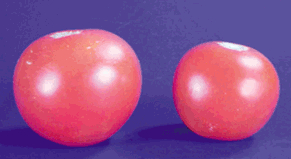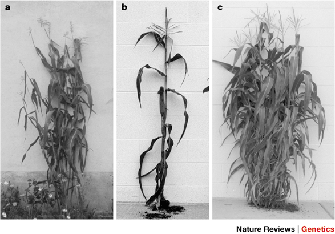« Prev Next »
More than a century after the work of Gregor Mendel, biologists are beginning to understand the genetic basis of complex traits in ways that Mendel probably never imagined. Unlike the yellow and green colors and round and wrinkled shapes of Mendel's peas, each of which arise from the actions of alleles at a single locus within the genome, complex traits arise from the segregation of alleles at many interacting loci. These interacting loci are known as quantitative trait loci, or QTLs. Recent advances in molecular genetics, combined with the use of powerful statistical techniques, have given biologists the means to actually map where in the genome (i.e., in which chromosomal regions) QTLs for particular traits are located. Basically, QTL mapping involves creating what is known as a "mapping population" and then using that population to measure associations between known genetic markers and measurable phenotypes. Whenever associations are found, the genetic marker in question is identified as a QTL.
Most QTLs are not actual genes or genetic loci, but rather chromosomal segments carrying the genes in question. In fact, some QTLs encompass hundreds of genes! Homing in the subset of genes involved requires extensive follow-up analysis, which can take years. However, the invaluable information that emerges from QTL studies is worth the wait, even when the identity of the specific genes involved remains a mystery. For example, scientists are currently employing data about QTLs for a number of practical purposes, such as improving the field of crop science. Scientists are also using this information to probe the principles of quantitative genetics in ways never before possible.
QTLs in Agriculture

QTL analysis has its greatest practical potential in agriculture. When it comes to crop science, the potential applications are two-fold. First, scientists can use QTL analysis as an initial step toward identifying important genes that might be genetically engineered into crop plants. Again, it may take years of follow-up study to translate QTLs into actual genes, but it can be done. In fact, it has already been done with fruit weight in tomatoes. Specifically, since the early 1980s, scientists have identified more than 28 QTLs for tomato fruit weight. It took researchers more than 10 years to localize just one of these QTLs, fw2.2, to a narrow chromosomal region and then identify and clone it. Through this process, the researchers finally discovered that the fw2.2 QTL corresponds to the ORFX gene. As Mauricio (2001) explains, an fw2.2 QTL (or ORFX) transgene inserted into a cultivated tomato plant (Lycopersicon esculentum) reduces the weight of the tomato fruit by an average of 15.5 grams. Thus, by selecting tomato plants that do not carry the fw2.2 QTL or the small-fruit-weight-associated ORFX allele, farmers can breed better (or at least larger) tomatoes (Figure 1).
Farmers also hope to use QTLs in what are known as marker-assisted selection programs. Such programs involve selectively breeding plants (or animals) not by directly selecting the trait of interest, but rather by indirectly selecting for that trait on the basis of QTLs (or other genetic markers) associated with it. One can imagine several situations in which marker-assisted selection would be advantageous. For example, consider a case in which the trait being selected (say, fruit size) was not expressed until late in a plant's development. In this situation, a farmer most likely wouldn't want to wait until the trait is expressed, because this wait costs time and money. Thus, by selecting for QTLs associated with fruit size, the farmer would be able to select early (i.e., while the plants are still far too young to actually bear fruit) for plants that will bear larger fruit at maturity—at least that's the idea.
In practice, while the idea of QTL-assisted selection has generated considerable excitement among scientists and farmers worldwide, it has yet to truly come to fruition. On top of the technical challenges associated with QTL analysis, the required technology is expensive, prohibitively so in many developing countries in which agriculture is a mainstay of the economy. As discussed during an electronic forum on marker-assisted selection programs sponsored by the Food and Agriculture Organization of the United Nations, in addition to the financial challenges associated with QTL analysis, there are also constraints created by intellectual property restrictions. For instance, much of the genomic and QTL information currently being accumulated is held by large, multinational agriculture companies and therefore not accessible to the scientific community at large.
Crop Plant QTLs: Not Just for Agriculture

Meanwhile, scientists are conducting QTL analyses in crop plants not just for the purpose of breeding better tomatoes, but also as a means of answering some crucial and still-unresolved questions about the quantitative genetic basis of evolution. The field of quantitative genetics rests on a largely statistical foundation laid by Karl Pearson and Ronald Fisher during the early 1900s. Today, quantitative geneticists are branching out, using molecular-based QTL analyses to revisit old questions, such as the genetic basis of adaptation. For instance, researchers are seeking to determine how many genes underlie important fitness traits, as well as whether these genes have "major" or "minor" effects. Conventional wisdom holds that most fitness traits are encoded by multiple interacting genes, with each gene exerting only a relatively minor effect by itself. This wisdom, however, has always been open to debate (Orr & Coyne, 1992; Mauricio, 2001). Moreover, QTL data suggest that, at least in some situations, fitness-related genes of major effect may be more important than suggested by Pearson and Fisher. For example, some of the more than 28 different QTLs that scientists have identified for fruit weight in tomatoes account for as much as 20% of the phenotypic variance in fruit weight (Mauricio, 2001). Twenty percent could arguably be construed as a "major" effect, contrary to conventional wisdom, which predicts a fitness-related trait like fruit weight should be encoded by multiple genes of "minor" effect.
Quantitative geneticists are also using QTL analyses to answer other questions, such as how many genes are required for macroevolutionary change (e.g., speciation). For instance, Mauricio (2001) points to the work that University of Wisconsin geneticist John Doebley and his colleagues carried out with cultivated maize (Zea mays ssp. mays) and its probable wild ancestor, teosinte (Zea mays ssp. parviglumis). Although it took Doebley's team more than 10 years of research, they finally identified some of the key QTLs responsible for a number of the phenotypic differences between Z. mays spp. mays and Z. maps ssp. parviglumis, including their single-stalk (cultivated maize) versus bushy (teosinte) morphologies (Figure 2; Doebley et al., 1997).
More recently, Ohio State University crop scientist Esther van der Knaap and her colleagues identified and localized the gene corresponding to one of the key QTLs, sun, responsible for tomato shape (Xiao et al., 2008). Like the fw2.2 gene that plays such a large role in governing tomato size, sun can be used as a transgene to create tomatoes of different shape. However, as is true of so many QTL studies in crop plants, this finding has attracted more attention because of its scientific rather than its practical implications. This is due in large part to the fact that Van der Knaap's team also discovered that the sun gene is a transposable element—a so-called "jumping gene" that jumped from chromosome 10 to chromosome 7 at some point during its evolutionary history. The translocation of the sun gene resulted in an increase in sun expression, which is responsible for the elongation of the fruit. This discovery serves as yet another example of how transposable elements, once dismissed as useless "junk" DNA, are finally earning recognition as genes with function.
The discovery of the sun gene and its elongated fruit phenotype also serves as an excellent example of how far the field of genetics has progressed since Mendel and his round and wrinkled peas. Thanks to Pearson, Fisher, and others, the field of genetics long ago evolved from one focused on studying simple "Mendelian traits" (that is, traits caused by genes at one or two loci) to one focused on studying quantitative traits, or those traits caused by multiple genes at multiple loci. Today, molecular biology and QTL technology are giving scientists the ability to study quantitative traits in new, more powerful ways than previously thought possible.References and Recommended Reading
Doebley, J., et al. The evolution of apical dominance in maize. Nature 386, 485–488 (1997) doi:10.1038/386485a0 (link to article)
Mauricio, R. Mapping quantitative trait loci in plants: Uses and caveats for evolutionary biology. Nature Reviews Genetics 2, 370–381 (2001) doi:10.1038/35072085 (link to article)
Orr, H. A., & Coyne, J. A. The genetics of adaptation: A reassessment. American Naturalist 140, 725 (1992)
Mauricio, R. Mapping quantitative trait loci in plants: uses and caveats for evolutionary biology. Nature Reviews Genetics 2, 375 (2001).
Xiao, H., et al. A retrotransposon-mediated gene duplication underlies morphological variation of tomato fruit. Science 319, 1527–1530 (2008) doi:10.1126/science.1153040



 Figure 2: The evolution of apical dominance in maize (Zea mays)
Figure 2: The evolution of apical dominance in maize (Zea mays)


























